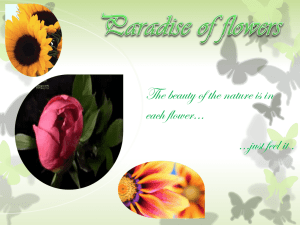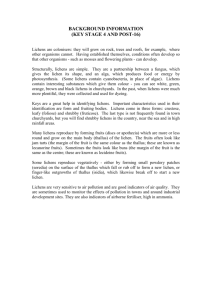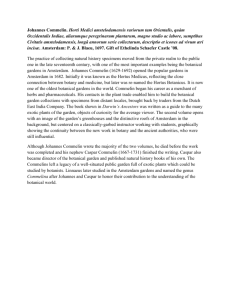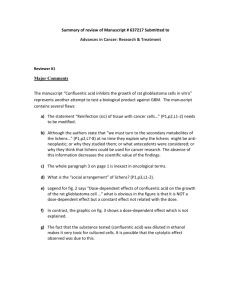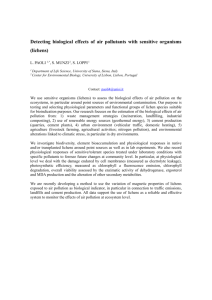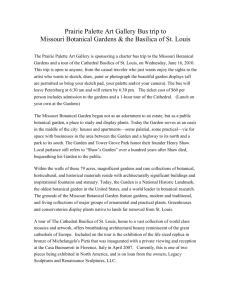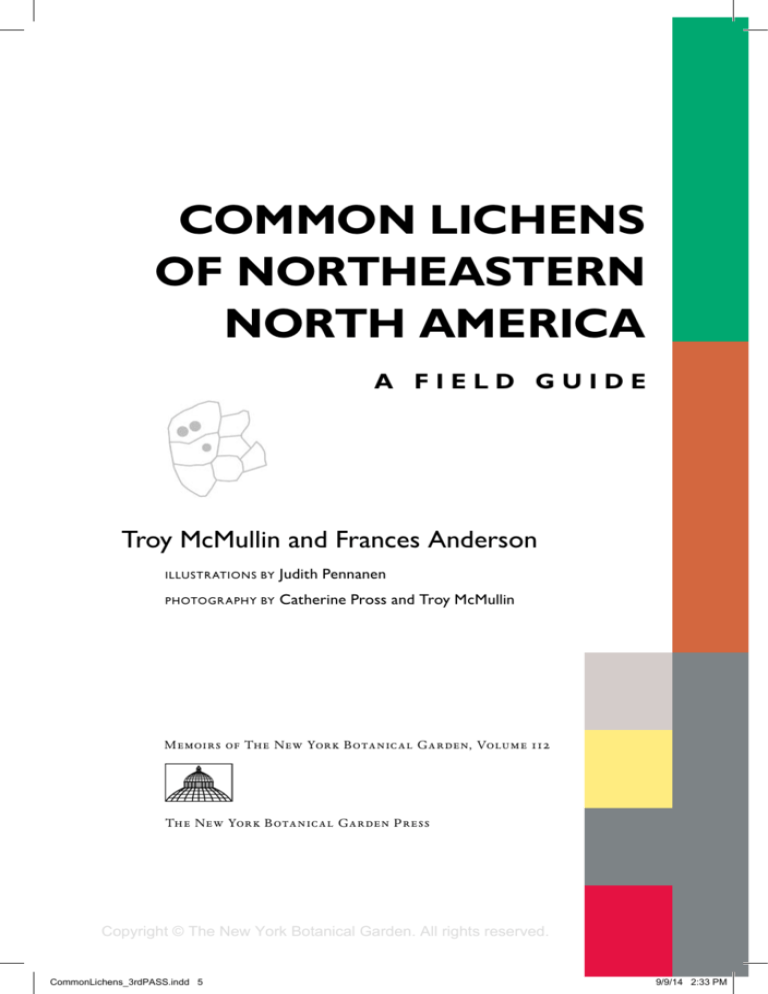
Common Lichens
of Northeastern
North America
a field guide
Troy McMullin and Frances Anderson
Illustr ations by
Judith Pennanen
photogr aphy by
Catherine Pross and Troy McMullin
Memoirs of The New York Botanical Garden, Volume 112
The New York Botanical Garden Press
Copyright © The New York Botanical Garden. All rights reserved.
CommonLichens_3rdPASS.indd 5
9/9/14 2:33 PM
Memoirs of The New York Botanical Garden
(ISSN 0077-8931)
The Memoirs are published at irregular intervals in volumes of various sizes and are
designed to include results of original botanical research by members of The New York
Botanical Garden staff or by botanists who have collaborated in one or more of The New
York Botanical Garden’s research programs. Ordinarily only manuscripts of 100 or more
manuscript pages will be considered for publication.
Manuscripts should be submitted to the Editor. For further information regarding
editorial policy and instructions for the preparation of manuscripts, contact the Editor.
Orders for published and forthcoming volumes should be placed with:
The New York Botanical Garden Press
2900 Southern Boulevard
Bronx, NY 10458-5126 USA
Customer service: 718.817.8721 • Fax: 718.817.8842
Email: nybgpress@nybg.org
Website: http://nybgpress.org
A DV I S O RY B OA R D
Patricia K. Holmgren, Director Emerita of the William and Lynda Steere Herbarium
The New York Botanical Garden
Scott A. Mori, Nathaniel Lord Britton Curator of Botany
The New York Botanical Garden
Robert F.C. Naczi, Curator of North American Botany
The New York Botanical Garden
E D I T O R I A L B OA R D
William R. Buck, Editor
The New York Botanical Garden
Bronx, New York 10458-5126 USA
Email: bbuck@nybg.org
Thomas F. Daniel
Department of Botany
California Academy of Science
Golden Gate Park
San Francisco, California 94118 USA
Copyright © The New York Botanical Garden. All rights reserved.
CommonLichens_3rdPASS.indd 3
9/9/14 2:33 PM
F ront C over :
book design:
Cladonia cristatella (British Soldiers)
Richard J. Oriolo
© 2014 The New York Botanical Garden
Published by The New York Botanical Garden Press
2900 Southern Boulevard
Bronx, NY 10458-5126 USA
All rights reserved. No portion of this book may be reproduced in any
form or by any means, including electronic storage and retrieval systems,
except by explicit, prior written permission of the publisher except for
brief passages excerpted for review or critical purposes.
Photo credits appear on pages 165–166 which constitute an extension of
this copyright page.
The paper used in this publication meets the requirements of the
National Standards for Information Sciences — Permanence of Paper
for Publications and Documents in Libraries and Archives, ANSI/NISO
Z39.48–1992.
Memoirs of The New York Botanical Garden, Volume 112 was issued on
December
2014.
Manufactured
China.
XX
July 2014
[ACTUAL
t/k fromin
printer]
ISSN 0077-8931
ISBN 978-0-89327-511-2
Copyright © The New York Botanical Garden. All rights reserved.
CommonLichens_3rdPASS.indd 6
9/9/14 2:33 PM
Contents
Introduction
1
About Lichens
3
What Are Lichens?
3
Why Are Lichens Important?
3
How Do Lichens Get Their Nutrients?
4
Lichen Reproduction
4
Lichen Names
5
Collecting Lichens
5
How To Use This Book
7
What Is It Growing On?
8
What Is Its Growth Form?
8
What Is the Main Color of the Upper Surface?
8
Is It a Rare Species?
TREE LICHENS
About This Section
SOIL LICHENS
About This Section
ROCK LICHENS
About This Section
11
13
15
103
105
137
139
acknowledgments163
photo credits
165
Further Reading
167
Glossary171
Index175
contributors181
the authors
182
Copyright © The New York Botanical Garden. All rights reserved.
CommonLichens_3rdPASS.indd 7
9/9/14 2:33 PM
Introduction
F o r m o s t p e o p l e , l e a r n i n g a b o u t lichens has not been easy, until
recently. Historically, the only guides available to identify lichens had
black and white photographs, which were often fuzzy or too distant to be
instructive, or they had line drawings. Most lichen literature was written
for professional lichenologists, using what amounts to another language to
describe the lichens and requiring a microscope and a number of chemicals
to identify the specimens.
The publication of Lichens of North America by Irwin Brodo, Sylvia
Sharnoff and Steve Sharnoff in 2001 opened the world of lichens to everyone. It was the first full-color guide to lichens on the continent, useful to
amateur naturalists and professional lichenologists alike. At nearly 4 kg
(8.5 pounds), it is a comprehensive volume made for the lab or coffee table,
not for lugging around in a backpack. Its beauty and readable text has created a new thirst for a portable and easy-to-use field guide, such as this one.
Common Lichens of Northeastern North America is designed for amateur
naturalists, nature interpreters, forestry workers, land surveyors, researchers and the general public. Meant to fit in a pocket or backpack, it requires
no previous experience using dichotomous keys, no use of chemicals, and
no microscopic examinations in a lab, though a hand lens is essential. Most
of the 138 species covered in detail in this book are identifiable to species
or at least to genus in the field. Each is shown in a full-color photograph,
accompanied by a drawing of the details that help with identification.
To make this guide easy to use, we have arranged the lichens as they
are encountered in the field, according to the surface they live on: trees,
Copyright © The New York Botanical Garden. All rights reserved.
CommonLichens_3rdPASS.indd 1
9/9/14 2:33 PM
rocks and soil, then by shape or growth form. If they are leafy they are
foliose; if they stand up like little trees or dangle from a branch they are
fruticose; and if they are a smear of color on a surface, often with tiny
dots, they are crustose. Then, they are grouped by color. Though colors
are subjective to individuals, we used generalized color groups that should
include any variations. Within color groups, there are further divisions,
according to the distinctive features of each species.
Technical terms are explained in the Glossary. There’s no escaping
the need to learn a few terms that describe lichen features. We have tried
to keep these to a minimum, and have designed a template for each lichen
that reinforces the same terms. When a lichen doesn’t have a particular
feature, the template will tell you so. Where possible, we have described
the Greek (G.) and Latin (L.) origins of the species’ names.
This is not a comprehensive guide to all lichens in the Northeast and
Canadian Maritimes, where there are several hundred species, maybe
more. After consulting with regional lichenologists we selected fieldidentifiable common species that occur in the Maritimes. Most also occur
in Newfoundland, Québec, Ontario and much of New England. To the
careful observer they should be identifiable in the field using only a hand
lens. We also chose to highlight some lichens which are either at risk or
considered rare, so that collectors will be cautious about collecting these
lichens or otherwise damaging their habitats.
We encourage anyone with an interest in lichens to use our guide as
a starting point. Lichens of North America and Macrolichens of New England
and other references (see Further Reading, p. 167) will provide additional
details on a greater number of lichens for those who want to study them in
earnest.
2
introduction
Copyright © The New York Botanical Garden. All rights reserved.
CommonLichens_3rdPASS.indd 2
9/9/14 2:33 PM
isidia
Lichen:
Punctelia rudecta
Rough speckled shield lichen
N a m e O r i g i n s : Punctelia (L.) = dotted, referring to the speckles (pseudocyphellae) on the upper surface; rudecta (L.) = rough, likely referring to combined appearance of the isidia and pseudocyphellae
F o u n d : On most tree types; occasionally on wood
C o lo r : Green-gray, often looking bleached out except for the
outer thallus edges; lower surface pale to light brown, occasionally with orange patches
S h a p e / s i z e : Lobes ≤ 8 mm, adhering closely to the substrate; upper surface
covered with conspicuous white speckles (pseudocyphellae), especially
toward the lobe tips
I s i d i a : Common; cylindrical, occasionally branched; dense toward the center,
sparse toward the lobe edges
S o r e d i a : None
A p ot h e c i a : Uncommon; brown
R h i z i n e s : Common; light brown, straight (simple); throughout the lower
surface
D i s t i n c t i v e F e at u r e s : Green-gray, isidiate thallus covered with white
speckles; pale-brown lower surface
N ot e s : Cetrelia (p. 28) species can appear similar. They also have conspicuous
white speckles, but the lobes are larger (≤ 20 mm), often more ruffled and
they have soredia not isidia. Their lower surface is dark brown to black.
Common Name:
18
Tree Lichens
Copyright © The New York Botanical Garden. All rights reserved.
CommonLichens_3rdPASS.indd 18
9/9/14 2:33 PM
isidia
Lichen:
Imshaugia aleurites
Salted starburst lichen
Imshaugia = after American lichenologist
Henry Imshaug (1925–2010); aleurites (G.) = flour-like,
likely referring to the color of the thallus
F o u n d : On bark and wood of conifers, usually in the open
C o lo r : Shiny, whitish gray above; white with tan areas below
S h a p e / s i z e : Round to oval-shaped thallus, with flat, strapshaped, 0.5–1.5 mm wide lobes radiating from the center;
≤ 5 cm across, growing closely attached to the substrate
I s i d i a : Abundant on the surface, except at the ends of the lobes; the
unbranched isidia are usually brownish at the tips
S o r e d i a : None
A p ot h e c i a : Rare
R h i z i n e s : Pale brown, abundant
D i s t i n c t i v e F e at u r e s : Shiny, flat, gray-white lobes and brown-tipped
isidia
N ot e s : In humid, sheltered habitats, Imshaugia aleurites can drape itself off
the branch it grows on, becoming almost pendent. Normally it adheres
closely to its substrate.
Common Name:
Name Origins:
common lichens of northeastern north america
19
Copyright © The New York Botanical Garden. All rights reserved.
CommonLichens_3rdPASS.indd 19
9/9/14 2:34 PM


